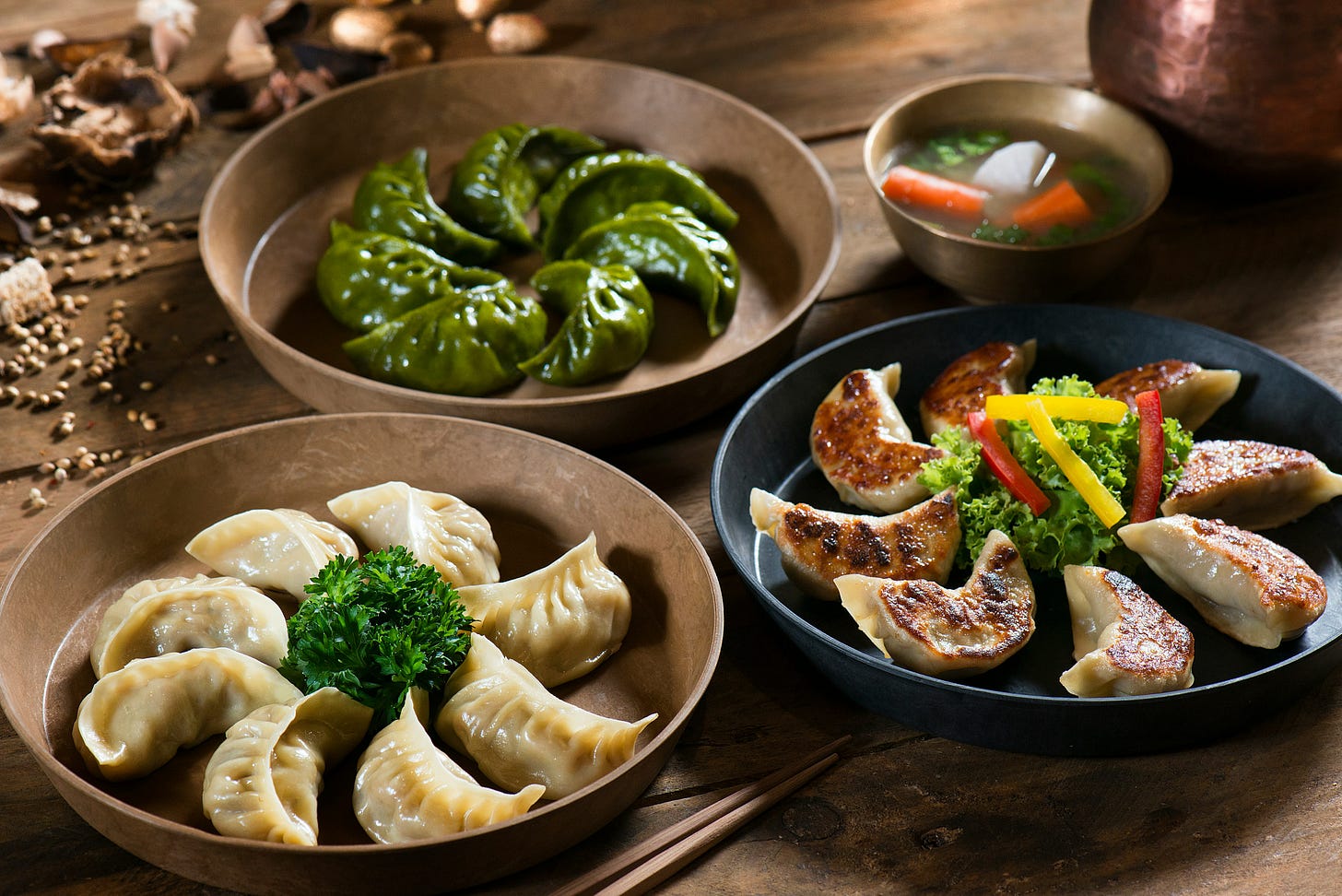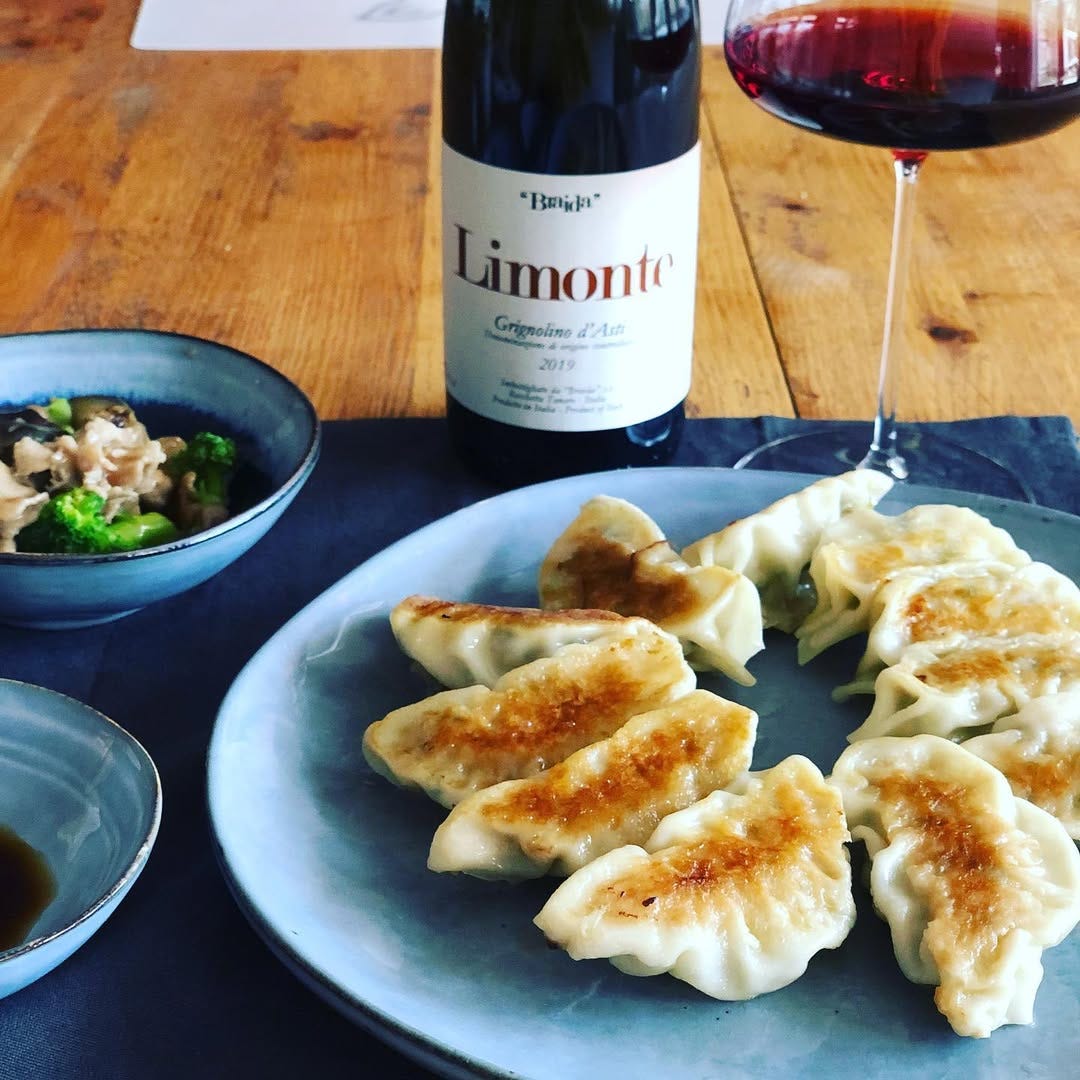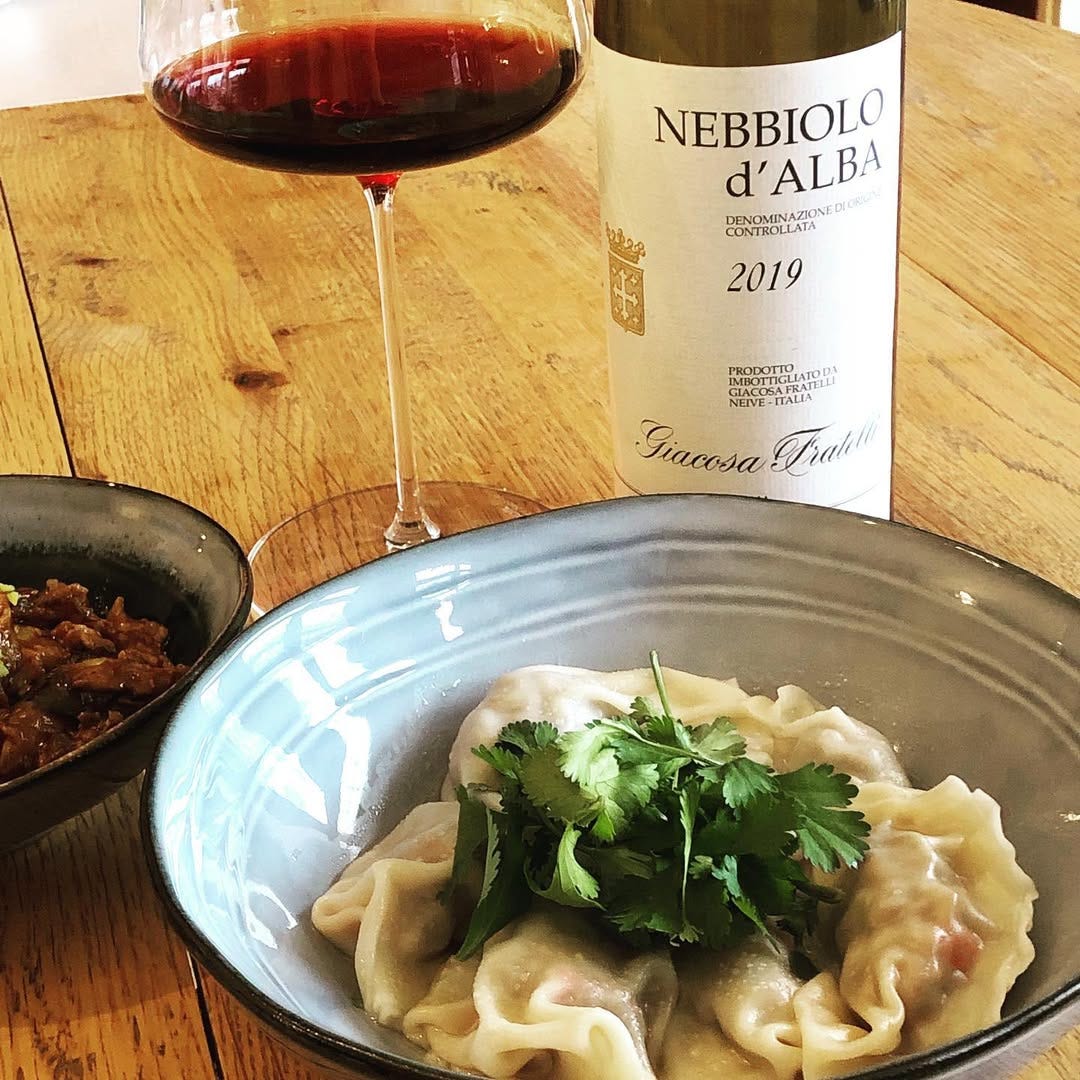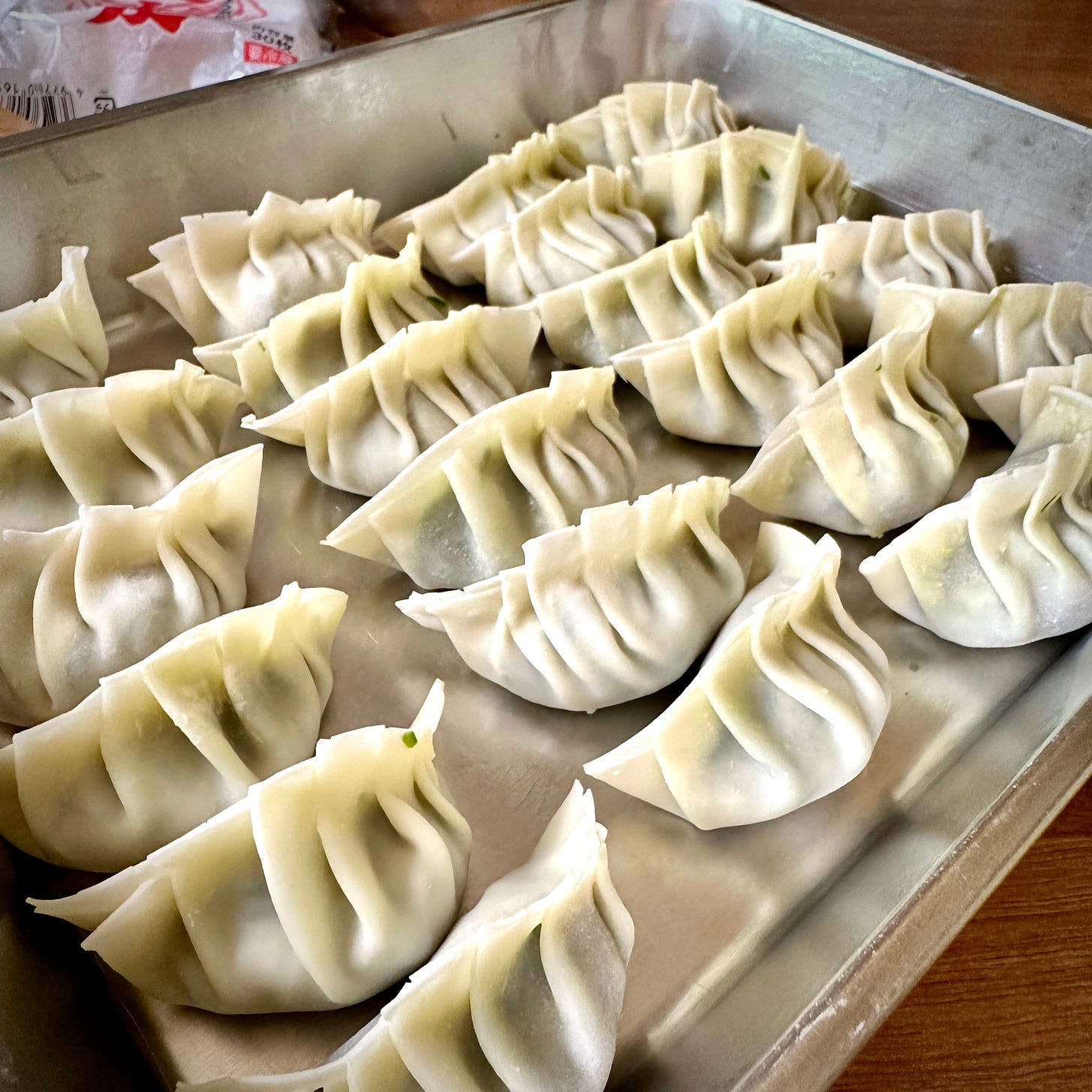Enhancing Gyoza (Japanese Dumplings) with Wine: A Passionate Pairing Guide
Discovering harmonious wine pairing ideas with five examples
In Japan, beer is the go-to drink for pairing with classic grilled dumplings (like the ones pictured above). But as a dedicated wine enthusiast, I can’t resist exploring wine pairings instead. During my WSET Diploma studies, I made it a mission to sample wines from the extensive recommended tasting list. To make it even more enjoyable, I explored wine-food parings alongside homemade dishes.
There is another backstory. One of my daughters, a notoriously picky eater, made an exception for dumplings—provided the ingredients were wrapped in dough, she didn’t question what was inside. As a result, I’ve unintentionally become something of a specialist in homemade dumplings and wine pairings. At the very least, I’ve experimented with a broader variety of dumpling-and-wine combinations than the average Japanese person.
Today, I’m excited to share five of my favorite pairings, along with the reasoning behind them. Hopefully, these insights will inspire your next dumpling and wine experience.
This is an article written by Japanese DipWSET, Kazumi.
Understanding Gyoza and Its Components
Pairing wine with gyoza is a rewarding culinary adventure. Japanese-style gyoza are typically pan-fried, giving them a crispy texture that complements their savory fillings. While pork is the most common protein, beef, chicken, and shrimp are also popular choices. Unlike traditional Chinese dumplings, Japanese gyoza wrappers are store-bought rather than handmade.
When selecting a wine, it’s crucial to decide which component to highlight: the crispy wrapper, the flavorful filling, or the tangy dipping sauce. A dry, effervescent sparkling wine can cut through the richness of fried dumplings and enhance the brightness of vinegar-based sauces. Meanwhile, a ripe Chardonnay or a fruity rosé can harmonize with a variety of fillings, elevating the dish as a whole.
Now, let’s dive into five exceptional pairings.
1. Crispy, Juicy Fried Gyoza & South African White Blend
First, let’s focus on the tangy dipping sauce. The standard gyoza sauce consists of equal parts soy sauce and rice vinegar, often with chili oil for heat. Some prefer a simpler mix of rice vinegar and white pepper, which might make it more wine-friendly.
To complement both the sauce’s acidity and the dumpling’s juicy filling, I recommend a South African Chenin Blanc blend. Hemelrand Vineyard 2017 from Alheit Vineyards combines 26% Chenin Blanc, 26% Chardonnay, 23% Roussanne, 21% Verdelho, and 4% Muscat, grown in the cool coastal climate of Hemel-en-Aarde, South Africa. This wine boasts an exotic nose, a perfect balance of vibrant acidity and rich fruit, and a toasty undertone.
The rationale behind this pairing is that there are multiple common aspects in both gyoza and wine: juicy filling and fruit-rich character on the palate; vegetable accents in both; grilled crispiness of gyoza and toasty overlay in wine. Then, the tangy sauce for gyoza and refreshing acidity and spiciness of wine culminates those experiences. Simply delicious!
2. Vegetable-Dominant Pork Gyoza & Dry Prosecco
Gyoza fillings typically include a mix of vegetables like cabbage, green onions, Chinese chives, and leeks—some widely available, others best found at Asian supermarkets, which oftentimes bold-flavors. For this pairing, I focused on a lighter version using more common vegetables, such as cabbage and green onions.
A fantastic choice is Prosecco Spumante di Valdobbiadene Superiore DOCG Brut by Adami, a high-quality Prosecco from one of the region’s top three producers. It was my standout favorite during a Prosecco tasting training, and its numerous accolades are well deserved.
The rationale behind this pairing is that these veggie-forward dumplings have a fresh, delicate character, making them a natural match for the herbal nuances of Prosecco, which is often harvested slightly early in warm climates. The dry, crisp bubbles cut through the frying oil, creating a refreshing contrast that enhances the dish’s balance.
3. Gyoza with Chinese Chives & Grignolino from Piemonte
This version features bold-flavored vegetables like plenty of chives, Chinese green onions, garlic, and ginger in the dumplings—ingredients I initially thought wouldn’t pair well with wine. But it’s possible to pair, or even eye-opening.
Grignolino from Piemonte proved to be an ideal match. This native Italian variety, often described as a lighter, “summertime version” of Nebbiolo, features delicate red fruit notes alongside a unique oolong tea aroma. Braida’s Grignolino d'Asti "Limonte" was a revelation.
The rationale behind this pairing is that the red fruit and tea-like nuances beautifully complemented the Chinese chives and leeks, while its polished yet ample tannins enhanced both the wine and the dumplings. Its naturally high acidity also helped cleanse the palate of any lingering oil.
4. Classic Pork Gyoza & Basic Cava
After exploring a bit tricky two, high-end Prosecco and a lesser-known indigenous red, let’s return to a more straightforward pairing.
This is the quintessential pork-and-vegetable gyoza—akin to the frozen dumplings widely available in Japanese supermarkets (though homemade in this case).
The rationale behind this pairing is that, in Japan, light beer like Asahi Super Dry is the classic companion for grilled gyoza. A dry, refreshing Cava serves as an excellent alternative. Instead of emphasizing a specific component like filling, wrapper, or sauce, this pairing focuses on overall balance. The earthy, toasty aromas and crisp acidity of Cava offer a similar experience to beer, making it a natural pairing.
On a side note, Cava is produced on a massive scale. In 2023, total shipments reached 252 million bottles, with over 70% destined for international markets. Industry giants Freixenet and Codorníu dominate production, accounting for approximately 75% of all Cava. While Codorníu mechanizes its grape growing and harvesting in Penedès, Freixenet sources hand-harvested grapes from contract growers. In either case, amazing numbers.
These large-scale operations ensure Cava remains readily available in major supermarket chains—just like pre-made dumplings.
5. Cumin-Lamb Dumplings with Tomato & Early-Drinking Nebbiolo
This version features lamb dumplings seasoned with cumin, ginger, and tomatoes, inspired by northeastern Chinese cuisine. The bold filling immediately reminded me of Nebbiolo, though I was pleasantly surprised by how well the pairing worked.
Nebbiolo d'Alba 2019 by Giacosa Fratelli, is lively and fruity, with balanced tannins and acidity. Early-drinking Nebbiolo, rather than Barolo or Barbaresco, proved to be the perfect match.
The rationale behind this pairing is that its fresh cherry and plum notes, along with floral hints of violets and roses, paired beautifully with the tomato-based filling. Additionally, the subtle stemmy, earthy spice in young Nebbiolo echoed the cumin, creating an unexpectedly harmonious match. The wine’s lively acidity and moderate tannins further enhanced the dish without overpowering it.
Conclusion: Endless Possibilities
Homemade gyoza can be endlessly customized by changing fillings and sauces, making the process of selecting a wine even more exciting. The combinations are limitless, allowing for constant discovery and enjoyment. I hope this post inspires you to experiment with your own pairings.
Now, I’m getting hungry—what kind of filling would you put in, and what sauce would you pair it with? Then, which bottle would you pick up?
If you want to know more wines or me, please follow my Instagram or LinkedIn too.
DeepLで、英語→日本語に翻訳しました。少し不自然ではありますが内容は合ってるので、時間短縮にどうぞ!
日本では、伝統的な焼き餃子(上の写真のような)にはビールが欠かせません。しかし、熱心なワイン愛好家である私は、ワインとの組み合わせも試さずにはいられません。WSETディプロマコースの受講中、私は推奨された幅広いテイスティングリストのワインを試すことを使命としていました。さらに楽しむために、私は自家製料理とワインのフードペアリングも試しました。
もうひとつ裏話があります。うちの娘のひとりは偏食で有名ですが、餃子だけは例外でした。餃子の皮で包んであれば、中身は問わないのです。その結果、私は知らず知らずのうちに手作り餃子とワインの組み合わせの専門家のような存在になっていました。少なくとも、一般の日本人よりも幅広い種類の餃子とワインの組み合わせを試してきました。
今日は、私が好きな組み合わせの中から5つを選び、その理由を説明したいと思います。これらの洞察が、皆さんの次回の餃子とワインの体験のヒントになれば幸いです。
餃子とその構成要素について理解する
餃子とワインの組み合わせは、料理の冒険として大きな楽しみをもたらします。日本風の餃子は通常、フライパンで焼くため、パリッとした食感となり、風味豊かな具を引き立てます。豚肉が最も一般的なタンパク源ですが、牛肉、羊肉、鶏肉、海老なども人気です。伝統的な中国餃子とは異なり、日本の餃子の皮は手作りではなく、市販のものが使用されます。
ワインを選ぶ際には、どの要素を際立たせたいのかを決めることが重要です。パリパリの皮、風味豊かな具、あるいはピリッと辛いつけだれ、どれを強調したいのか。辛口で活き活きとしたスパークリングワインは、揚げ餃子のこってり感を和らげ、酢ベースのソースの明るさを引き立てます。一方、熟したシャルドネやフルーティーなロゼは、さまざまな具と調和し、料理全体を引き立てます。
それでは、5つの素晴らしい組み合わせをご紹介しましょう。
1. クリスピーでジューシーな揚げ餃子と南アフリカの白ワインブレンド
まず、ピリ辛のディッピングソースに注目してみましょう。 餃子用のソースは、醤油と米酢を同量ずつ混ぜ合わせたものが一般的で、辛味を加えるためにラー油を加えることもよくあります。 もっとシンプルに米酢と白胡椒を混ぜ合わせたソースを好む人もいますが、その方がワインと合わせやすいでしょう。
ソースの酸味とジューシーな餃子の具の両方を引き立てるには、南アフリカのシュナン・ブラン・ブレンドがおすすめです。アルヘイト・ヴィンヤーズのヘメルランド・ヴィンヤード2017は、ヘメル・エン・アードの冷涼な沿岸気候で栽培されたシュナン・ブラン26%、シャルドネ26%、ルーサンヌ23%、ヴェルデーリョ21%、マスカット4%をブレンドしています。このワインは、エキゾチックな香り、生き生きとした酸味と豊かな果実味の完璧なバランス、そしてトーストの香りが特徴です。
この組み合わせの根拠は、餃子とワインの両方に共通する要素が多数あることです。ジューシーな餡と豊かな果実味、両方に野菜の風味、餃子のグリルされたパリパリ感とワインのトースト香。そして、餃子のピリ辛ソースとワインの爽やかな酸味と辛味が、その体験を最高のものにします。とにかく美味しい!
2. 野菜が主役の豚肉餃子と辛口プロセッコ
餃子の具には、キャベツ、ネギ、ニラ、ネギといった野菜が一般的に使われますが、広く入手できるものもあれば、アジアンスーパーで探すのが最適なものもあります。この組み合わせでは、キャベツやネギといったより一般的な野菜を使ったあっさりしたバージョンに焦点を当てました。
素晴らしい選択肢は、この地域のトップ3の生産者のうちの1つであるアダミ社の高品質なプロセッコ、プロセッコ・スプマンテ・ディ・ヴァルドッビアーデネ・スペリオーレDOCGブリュットです。これは、プロセッコのテイスティング研修で私が最も気に入ったもので、数々の受賞歴は当然のものです。
この組み合わせの理論的な背景は、野菜を前面に押し出したこの餃子はフレッシュで繊細な特徴を持っているため、温暖な気候でやや早めに収穫されることが多いプロセッコのハーブのようなニュアンスと自然にマッチするということです。辛口でキリッとした泡が揚げ油の油っぽさを和らげ、料理のバランスを向上させる爽やかなコントラストを生み出します。
3. チャイニーズ・チャイブとグリニョリーノのピエモンテ風餃子
このバージョンでは、ニラ、ネギ、にんにく、ショウガなど風味の強い野菜をたっぷりと餃子に入れています。当初はワインと合わせるのは難しいのではないかと思っていましたが、実は相性が良く、目から鱗が落ちるような組み合わせなのです。
ピエモンテのグリニョリーノが理想的な組み合わせであることが判明しました。このイタリア原産の品種は、ネッビオーロの軽い「夏バージョン」と表現されることが多く、繊細な赤い果実の香りと独特なウーロン茶の香りが特徴です。Braidaのグリニョリーノ・ダスティ「Limonte」は、まさに目からウロコでした。
この組み合わせの理論的な背景は、赤い果実と茶葉のようなニュアンスが、中国産のニラやネギの風味を美しく引き立てるということ、そして洗練されていながら豊かなタンニンがワインと餃子の両方を引き立てるということである。また、自然な酸味が、口の中に残る油っぽさをすっきりと洗い流してくれる。
4. クラシックな豚肉の餃子とベーシックなカヴァ
少々癖のある2品、高級プロセッコとあまり知られていない在来種の赤ワインを試した後は、よりシンプルな組み合わせに戻りましょう。
これは、豚肉と野菜の餃子の典型的な一品です。日本のスーパーマーケットで広く販売されている冷凍餃子に似ていますが、この場合は手作りです。
日本では、アサヒスーパードライのような軽めのビールが焼き餃子にぴったりです。 辛口で爽やかなカヴァは、素晴らしい代替品となります。 具、皮、ソースといった特定の要素を強調するのではなく、この組み合わせでは全体のバランスを重視します。 カヴァの土っぽい香りとトーストの香り、そして爽やかな酸味は、ビールに似た体験をもたらし、自然な組み合わせとなります。
余談ですが、カヴァは大規模に生産されています。2023年には総出荷量は2億5200万本に達し、そのうち70%以上が海外市場向けでした。業界大手のフレシネとコドーニュが生産の大半を占め、カヴァ全体の約75%を占めています。コドーニュはペネデスでブドウの栽培と収穫を機械化していますが、フレシネは契約栽培者から手摘みしたブドウを調達しています。驚くべき数字です。
このような大規模な生産体制により、大手スーパーマーケットチェーンでは、まるで既製品の水餃子のように、いつでも気軽にカヴァが手に入るのです。
5. クミン風味のラム肉入り水餃子、トマトと早飲みネッビオーロ
このバージョンでは、クミン、生姜、トマトで味付けしたラム肉入り水餃子を紹介します。これは、北東中国料理から着想を得たものです。大胆な具材を見て、私はすぐにネッビオーロを連想しましたが、この組み合わせがうまくいくことに驚きました。
ジャコサ・フラテッリ社のネッビオーロ・ダルバ2019は、生き生きとしてフルーティーで、タンニンと酸味のバランスが取れています。早飲みタイプのネッビオーロは、バローロやバルバレスコよりも完璧な組み合わせであることが分かりました。
この組み合わせの理由は、フレッシュなチェリーとプラムの香りにスミレやバラのフローラルな香りが加わった風味が、トマトベースのフィリングと見事にマッチしたことにある。さらに、若いネッビオーロの繊細な茎や土っぽいスパイスの風味がクミンの風味と共鳴し、思いがけないほど調和の取れた組み合わせとなった。ワインの生き生きとした酸味とほどよいタンニンが、料理を圧倒することなく、さらに引き立てた。
結論:無限の可能性
自家製餃子は、具やソースを変えることで無限にカスタマイズでき、ワイン選びのプロセスをさらにワクワクするものにしてくれます。組み合わせは無限にあり、常に新しい発見と楽しみがあります。この記事が、皆さんにも自分なりの組み合わせを試してみようという気持ちになっていただけたら幸いです。
今、お腹が空いてきました。あなたならどんな具材を入れますか?どんなソースを合わせますか?そして、どのボトルを手に取りますか?
「世界のペアリング:ワイン、日本酒、その他!」をお読みいただきありがとうございました。新しい投稿を受け取り、私の活動を支援するために、ぜひ無料購読をお願いします。
日本ワイン、日本酒に関し(オランダから)プロモーションや通訳等のお手伝いをしていきたいと思っています。お仕事の依頼はこちらからお願いします。










Very interesting pairings, thank you. I like the chive dumplings with Grignolino, and particularly the lamb with Nebbiolo. Robert Parker recommended dumplings with aged Nebbiolo, and it was one of the few things I ever agreed with him about.
You've made me hungry for my Taiwanese mother-in-law's jiaozi (well, to be honest, I'm always hungry for those). Bubbles, fruity whites and earthy reds - excellent wine choices!